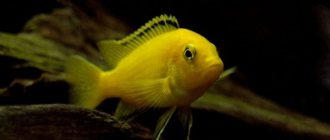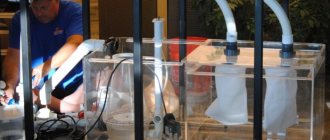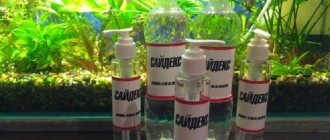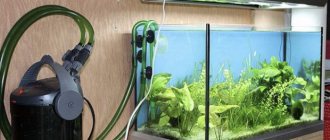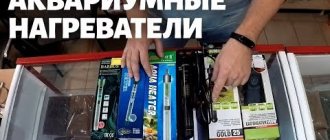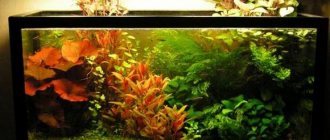The aquarium itself
Naturally, first of all you need to purchase the tank itself. Let's start choosing the material for its manufacture. There are only two options here - glass or acrylic. Each of them has its own pros and cons.
The advantages of an acrylic aquarium are that:
- it is cheaper than glass;
- lighter in weight;
- it is stronger;
- there are no leaking seams;
- more choice regarding tank shapes.
The main disadvantage of acrylic is that it can easily be scratched, and even one grain of sand on a cloth while wiping will be quite enough for this.
In addition, cheap acrylic will turn yellow over time. Also, for cleaning you will need special products, since ordinary household chemicals will not work here; they make this material cloudy, which makes maintaining an artificial reservoir more expensive. Find out how to choose a filter and background for your aquarium, how to start it up, and how to measure water hardness.
If we talk about glass, today many aquarium owners call it a relic of the past, believing that a glass tank is inferior to acrylic in everything. The only thing is that they advise you to buy expensive acrylic so that it doesn’t look like a piece of cheap plastic. In general, of course, this is a matter of taste. Some people like glass aquariums, others like acrylic ones.
The next point is the size of the tank, that is, height, width and depth. Beginners are advised to buy deep and wide aquariums, which are easier to decorate and, in the future, to care for. If we talk about the volume of an artificial reservoir, then you should start from how much free space you have for it, and from how many inhabitants you want to put there.
Important! Please note: the larger the aquarium, the easier it is to maintain! Beginning aquarists often make the mistake of thinking that it is better to purchase a small tank.
The recommended minimum volume is from 60 liters, the optimal is 100 liters.
But here, again, everything is at your discretion and taking into account your capabilities. Next, you should dwell on the shape of the artificial reservoir. They are extremely varied. Here and:
- panoramic;
- rectangular;
- corner;
- round
- in the shape of a cube.
In addition, non-standard tanks are sold - cylindrical, octagonal, glass-shaped, etc. There is plenty to choose from. The main thing is to make sure that you like it and fit into the overall interior of the room where the aquarium will be located.
It’s difficult to answer unequivocally which brand of tank you should choose. After all, someone can afford a more expensive model, while for others their finances will not allow such an opportunity. My only advice is to pay attention to the equipment that comes with the aquarium. Perhaps this moment will help you make your final choice.
LiveInternetLiveInternet
So, let's say you have an aquarium in which fish live, perhaps plants grow, and all sorts of events happen that are interesting to watch. The key point in the above is “interesting to watch.” A well-groomed, well-lit, and even beautifully decorated aquarium has the unique property of attracting the eyes and attention of others, and attracting it so much that it can be difficult to stop watching it. To the point that a situation can happen when, before leaving for work, you sit down “for a minute” near your home pond, and you sit there for about thirty minutes. It’s good if you work on a flexible schedule, and you won’t be scolded or fined at work, but not everyone works on a flexible schedule, and such situations also happen to them... What can we say about the evening, when after work most people want to... then distract yourself, relax, get rid of negative thoughts.
And what is most often used for this? TV... I won’t talk about my attitude towards this zombie box here, but I can definitely say that AQUARIUM IS MORE INTERESTING THAN TV!!! Even despite the fact that it does not broadcast all sorts of reports about political ups and downs, disasters, chronicles of incidents in their hometown, coupled with the weather forecast. You can sit in front of the aquarium for hours in the evening, watching the small bright fish that are in constant motion; you can admire the lush greenery of aquatic plants or watch hordes of small shrimp, constantly collecting microscopic particles of food from the ground or plants. And at this moment you think ABSOLUTELY NOTHING!!! Neither about work, nor about problems, you don’t make grandiose plans for the future. In general, you are completely distracted, plunging into a kind of meditative, abstract state. In a word, the effect is amazing!!!
What is the reason for such an attractive and even hypnotic effect of a small underwater world??? I don’t have an answer to this question, of course there are some assumptions, but there is no exact answer. We can only say that many people, once they have an aquarium, can no longer imagine their lives without this hobby. And, even if for one reason or another some give up this activity, sooner or later they will again have a pond with glass banks and schools of tropical fish at home. And everything would be fine, but to obtain such an effect, the aquarium must be well-groomed and clean. Accordingly, something needs to be done with it. And what?
Here's the thing: you need to maintain the aquarium. Maintaining an aquarium is a creative process. The fact is that no two aquariums are the same. You can put two aquariums next to each other, decorate them on the same day, and you can be sure that something in them will be different, to the point that in one there will be “everything is good” and in the other “everything is bad.” This is probably the difficulty of such an activity as aquarium keeping. There may be dozens of ways to solve the same problem, and it is not a fact that a method that worked in one aquarium will work in another. Fortunately, all the various processes that take place in the aquarium are connected with each other in a certain way, and these connections are the same everywhere. By operating with them, understanding them, we can influence some parameters, thereby changing the situation in the aquarium, in accordance with our ideas about beauty and harmony. So, let's move on to the main topic of this article: how to maintain an aquarium so that it is always clean. It can be considered a fact that any aquarium in which biological equilibrium has been established requires attention from its happy owner for approximately 1 hour a week or less. This also applies to small reservoirs and those with a volume of more than 1000 liters. The same can be said about freshwater and marine aquariums. Perhaps the only ones that stand out from this series are the large-volume “herbal gardens”, designed in the “Dutch” or near-Dutch style, which is where you have to work hard doing thorough weekly weeding, but we are not talking about them now.
You have an aquarium with artificial plants, various decorations, driftwood, ceramics, and stones. If you assume that your aquarium may not be in ideal condition for some time, you can pay attention to it once every two weeks. True, it may take a little more time, but no more than 2 hours. You can clean the aquarium once a month. Most likely it will take more than 2 hours. Or you can do it once a year before guests arrive, although in this case it may take the whole day and may not be very useful for the inhabitants, and you will also be deprived of the joy of daily contemplation of your underwater world (in principle, with this approach before cleaning, and on other days thoughts may creep in, maybe it’s better to throw it away, since unkempt aquariums leave an extremely unpleasant impression), for example: imagine a corner in your house that hasn’t been dusted for a year, and even various things have been thrown into it (books, socks, apple cores), so the aquarium will look even worse...
Water change
It is necessary to replace the water once a week; along with the water, metabolic products of all inhabitants of the aquarium are removed, the accumulation of which in the water significantly increases the growth rate of algal fouling. It is necessary to replace 1/6-1/3 of the water depending on the needs of the fish (some like fresh water, others not so much), the power of the filtration system (the worse it is, the more water must be changed). Most often, it is enough to change ¼ of the water per week. The most convenient way to do the change is not by scooping up the water with a jar, but by extending a hose from the toilet to the aquarium and using the very useful law of Archimedes.
Soil cleaning
Occurs along with substitutions. In the simplest case, you put a plastic bottle with a cut bottom on the end of the hose that takes water from the aquarium and launch this improvised siphon directly into the ground. See what happened!!! Otherwise, it would all decompose in the aquarium. Just make sure that the siphon does not suck too much soil, which in this case will go straight into the toilet. When moving the siphon, clean all the soil, if necessary, moving large decorations (under them there is especially a lot of dirt), and along the way, do not forget to monitor the water level. By the way, for lovers of house plants, an aquarium can serve as a source of very valuable fertilizer. Try watering your plants with aquarium water containing soil residues and enjoy the effect! By the way, sellers often tell a myth: buy catfish, they will clean the soil. The maximum they can do is eat up the remaining food from the rest of the fish, often stirring up the water, and then everything is like everyone else, only they will work to pollute...
Glass cleaning
Another myth. Buy a sticky catfish, a snail, a shrimp. The glass will be cleaned. Yes, they crawl on the glass, yes, they leave traces behind them, eating something from them, but to clean the glass to a completely transparent state... Only a person with a scraper is capable of this. To clean glass in small aquariums, you can use dishwashing sponges (just make sure there are no iron threads in the foam rubber) or special aquarium scrapers. The most convenient are scrapers from Hagen, as well as blade scrapers from Tetra. There are also magnetic scrapers on the market (they are attached to the aquarium on both sides of the glass. And with their help you can clean the aquarium without getting your hands wet), but they are worth purchasing only if you clean the glass daily. They may no longer be able to cope with fouling that was a week old.
Cleaning the filter
Treat as optional weekly procedures. Look, if the volume of water passing through the filter is quite good, then wait another week. And rinse only when the stream becomes noticeably weaker. This applies to internal filters. External filters, depending on operating conditions, should be washed every 2-6 months. And some are in very good condition even after a year of work. Remember one important point. When washing the filter, its ability to purify water from toxic nitrogen compounds decreases, SO!!! After flushing, refrain from feeding the fish for two days and avoid a sudden increase in fish numbers for about 5 to 7 days.
Cleaning the scenery
Also refer to optional weekly procedures. Cleaning can be done directly in the aquarium with a toothbrush or a small plastic clothes brush. In difficult cases (corals, severe pollution, plastic plants, ceramics), you can resort to chemical cleaning: place the decorations in a warm or hot solution of the WHITE detergent (1/5 - 1/4 bottle per 1 bucket of water) and keep them in this solution 20-30 min. All dirt will disappear!!! ATTENTION!!! After soaking, it is necessary to thoroughly rinse the decorations under running water to avoid poisoning the fish. That's all! You can also give one simple and useful piece of advice. If there are no live plants in your aquarium, turn on the light only for the time when you are observing it. This will greatly reduce the growth rate of algal fouling and, accordingly, save your precious time. I have examples where aquariums in which this recommendation is followed remain absolutely clean for 2 or more months, despite the fact that the only operation that is carried out in them is replenishing the auto feeders (about once a week).
Below are some tips on how to behave in situations when there is “something wrong” with your aquarium, as well as how to make your life easier when maintaining your aquarium.
MUDDY WATER
If you notice that the water in the aquarium for some reason has acquired a cloudy-whitish hue and at the same time has begun to emit an unpleasant odor, and the fish are behaving restlessly and have even begun to die, then DO NOT GIVE ANY GRAM OF FOOD until the water becomes completely clear . If the water has not cleared in 3-5 days, then you need to seriously think about filtration, the number of fish in the aquarium... there can be many reasons...
LIGHT
The MORE you illuminate the aquarium, the FASTER it becomes contaminated with algae fouling on decorations and glass. If there are no live plants in the aquarium, turn on the light only to observe the fish and fouling will develop much more slowly.
DIRTY SCENERY
If your aquarium has corals or other decorations that are heavily dirty, place them in a solution of WHITE detergent (1/5 - 1/4 bottle per 1 bucket of water) and keep them in this solution for 20-30 minutes. All dirt will disappear!!! ATTENTION!!! After soaking, it is necessary to thoroughly rinse the decorations under running water to avoid poisoning the fish with chlorine compounds.
GREEN WATER
If your water begins to bloom (it turns light green), do not try to get rid of it by changing the water; it is better to completely shade the aquarium for 3-4 days. Be sure to aerate the water well.
WARNING
NEVER purchase an aquarium, equipment, fish and plants on the same day!!! Thus, you will almost 100% encounter many problems that will lead to the death of your new pets. If you still bought everything in one day, then don’t be too lazy to buy an ammonium remover as well. For example: JBL AmmoEx for ammonium removal, HAGEN ammonium remover. There are removers from other companies, but the ones listed above have been personally tested and cope with this task perfectly. True, they can most often be used only in external filters, placing them as the last filter layer.
DISEASES
If your fish gets sick with something, don’t think that everything will go away on its own. This happens, but very rarely. The sooner you start treatment, the more fish you can save.
semolina
Probably the most common disease is ichthyophthyriosis, also known as semolina. When the body and fins of the fish are covered with white grains. The drug Kostapur from Sera and Protozol from the same company have proven themselves to be effective against this disease.
SCRAPS
Among all aquarium glass scrapers, the best and most durable is the Hagen scraper; it allows you to easily remove almost all types of fouling from glass. Magnetic scrapers are not so good; the main condition for their use is daily cleaning of glass; they can no longer cope with older stains.
SNAILS
It happens that the number of snails in an aquarium exceeds any acceptable limits. They get stuck in the filter, eat plants, and stick to glass.
You can get rid of them in several ways:
1. Get a botia fish (clown botia, marble botia, lecomte botia), acanthophthalmus.
2. Apply the chemical: Tetra ZMF LIMNACID, JBL Schnecktol.
3. Place a torn leaf of cabbage, lettuce or carrots cut lengthwise on the bottom overnight. In the morning, a lot of snails will accumulate on them, which can be removed from the aquarium along with leaves or carrots.
FEED
Most fish in an aquarium can survive without feeding for up to 14 days. The main thing is that at this time all the main life support systems are working properly.
CARE
The aquarium requires maintenance, but not as often as it might seem. In addition to daily feeding, it is usually enough to spend about 1 hour a week on the aquarium and it will always be in excellent condition. It is interesting that this time is approximately the same for aquariums with a volume of 60 liters and 1000 liters.
=> How to care for an aquarium? There is absolutely no time for this ? <=
Studio "UNDERWATER WORLD"
Detailed information at: https://aquamirstudio.ru/
Cabinet
If you have decided on the aquarium, let's move on to the next important stage - choosing a cabinet for it. Of course, the tank can be placed on any other flat, stable surface, but still the cabinet is a convenient and useful thing. For example, you can store things for caring for your aquarium in it.
When deciding to buy a cabinet, consider the main points:
- it must be moisture resistant;
- durable, easily supporting the weight of a filled tank;
- It is desirable that it be on adjustable legs.
To avoid deformation of the cabinet under the weight of the aquarium, some opt for a metal product.
But such a cabinet will cost more. Did you know? Researchers from the USA have found that people who have an aquarium at home are more successful in their careers, creativity and personal relationships. Perhaps this is due to the fact that the owners of artificial reservoirs watch the fish every day before going to bed and always wake up cheerful and in a good mood.
Master's absence
It has already been mentioned that your vacation can be a real problem. The absence of an owner often threatens fish with negative consequences. If any other animal can be left to relatives, friends or neighbors, then in this case everything will be much more complicated. Firstly, you will have to leave the key to the apartment or transport the entire system to temporary guardians. Secondly, you need to entrust this task to people who also have special skills in caring for fish and can constantly monitor them. If the person you entrusted with the aquarium is inattentive and simply forgets about something, an unpleasant surprise will await you upon returning from vacation.
Additional lighting
Now let's move on to discussing additional lighting for an aquarium with fish, which is also very important and necessary. The development of plants, the growth of fish, their reproduction, etc. will depend on the lamp. It is better not to use incandescent lamps for an aquarium; they are more suitable for terrariums. Yes, the price may be attractive, but they are still not recommended for use for such purposes, since they have high heat transfer and can provoke algae outbreaks.
It is better to opt for fluorescent lamps. They have plenty of advantages:
- there will be a little heat, which is what we need;
- have a wide range of spectral radiation, which is important;
- can cover a large surface area;
- they contain actinic light, which has a beneficial effect on some inhabitants of the “bottom of the sea”;
- among them there are lamps with high luminous efficiency, these are marked: VHO (Very High Output) or HO (High Output).
Beginners are advised to use T5 lamps, which, with a relatively small diameter, have high luminous efficiency and spot light emission.
There are also metal halide lamps that create a “sparkling light” effect in the tank (like the sun in shallow water). But they have the same disadvantage as incandescent lamps - a lot of heat generated. Familiarize yourself with the rules for caring for such common aquarium fish as: clownfish, veiltail, gura, guppy, barb, parrotfish, mollies, goldfish, swordtail, platie, zebrafish, betta, astronotus, lalius, minora, discus, arowana , surgeonfish, dario dario, angelfish, macropod, macracanthus, cichlids, rhodostomus and labeo.
To avoid overheating of the water, you will have to additionally equip the aquarium with cooling fans, and also turn off the lamp for at least an hour every day.
And the cost of such lighting is a bit steep. When purchasing, pay attention to the lamp power. Consider one important point - the power of the light flux should not fall below 0.5 W per liter of water. More is okay, but not less! Also consider the color temperature of the lamp:
- 5500K-6500K - for lighting shallow fresh water tanks, sometimes for a reef aquarium;
- 10000K and more - for reef aquariums, deep-sea marine plants and fish;
- 20000K and more - for deep-water artificial reservoirs.
When purchasing additional lighting, you can use this sign:
| Aquarium length | Volume (l) | Lamp length(cm) | Lamp power (W) | Number of lamps (pcs.) |
| 40 | 25 | 30 | 8 | 1 |
| 50 | 45 | 45 | 15 | 1 |
| 60 | 55 | 45 | 15 | 1 |
| 80 | 128 | 60 | 18 | 2 |
| 100 | 250 | 90 | 30 | 4 |
| 120 | 300 | 100 | 38 | 4 |
| 130 | 325 | 120 | 36 | 4 |
| 150 | 375 | 120 | 36 | 4 |
| 160 | 400 | 150 | 58 | 4 |
Inhabitants of the "lazy" herbalist
If you decide to introduce fish into the herbalist, then there should be few of them - up to one dozen individuals. These can be neons, Notropsis chrosomus (rainbow), guppies, barbs, tetras, joyomus. Shrimp are also good inhabitants of the herbalist.
You can, for example, put an angelfish in an aquarium, but then you will need to create completely different conditions. As for goldfish and astronotuses, they are absolutely not suitable for keeping in a reservoir of this type, since the former like to eat up the roots, and the latter love to “re-equip” the entire interior for themselves.
Large fish cannot be placed in the herbal tank. Since you have a herbalist, then the grass in this aquarium is a priority, and the fish are a completely different story about a completely different type of aquarium. At a minimum, large fish will destroy your specially selected plants.
Heater
Another component of aquarium equipment is a heater, which comes in three types:
- bottom - it is installed in the ground, which has a beneficial effect on plants;
- external flow - placed outside the tank, cutting into the filter hose, which guarantees uniform heating of the water flow;
- submersible - lowered into water to a certain mark.
When purchasing, be sure to find out about its power and functionality of the thermostat (it will control the temperature itself and, if necessary, turn the heating on and off).
Important! If the thermostat breaks and switches to heating mode, you can simply cook all the inhabitants of the artificial pond. Therefore, be careful and be sure to ensure that the device is in good working order!
If you don't know what heater power to choose, remember: 1 watt of power per liter of tank volume. But no more!
Regular Maintenance
If you think that all care will be limited to feeding, then you are very mistaken. You need to devote quite a lot of time to maintaining the aquarium. For example, it is necessary to constantly monitor the level of ammonia, nitrites, nitrates, as well as pH, AC and PG, since all this is necessary for the normal life of fish in the aquarium. In addition, you need to regularly clean the filter, monitor the condition of the bottom and aquarium glass walls (so that there is no plaque). It should also be said that small tanks can cause many more problems than large ones. If any problems arise (changes in the chemical composition of water, temperature conditions), then the process occurs very quickly (within hours and even minutes). Lack of timely assistance threatens the death of the fish. That is, you need to constantly monitor what is happening in a small aquarium, since there is no other way out.
Stand for spoons and forks from a regular tin can: master class
Grandma has been gone for 10 years. “I revived” her old photo, and now I’m admiring the video
Scientists have conducted the most accurate test of Newton's law of universal gravitation
Compressor
Next on the list of required equipment for an aquarium is a compressor, because it supplies air and aerates the water. When purchasing a device, pay attention to:
- power;
- noiselessness;
- air flow adjustment.
To understand the power you need, you need to multiply the volume of the aquarium by 0.5. Usually the packaging contains information about the power of the device. You can check the noiselessness only by turning on the compressor. Regarding the adjustment of the air flow, it is carried out either by a valve that blocks the flow, or by changing the performance. The second option is more economical in terms of electricity consumption and quieter.
Filter
Everyone understands that this device must certainly be in the aquarium, because without it it will not be possible to maintain cleanliness and order. There are four types of filters:
- bottom;
- external;
- interior;
- canister
The bottom apparatus is placed under the soil, which is used as a filter element.
At the same time, the soil does not sour, which is important. But the complexity of installation and further maintenance is its big drawback. It is not particularly suitable for a home aquarium. An external filter, as you already understood, is installed outside the water. And this is very convenient, since there will be no problem taking it out to wash it. Check out the top 10 best aquarium plants.
Such elements allow you to clean your water with three types of filtration. The most budget option is an internal filter. True, it is relatively small, so you will have to place the filter media in it often. It is this option that is most often found in home aquariums. A canister filter is essentially another type of external filter. Only in comparison with the latter, its filter media are located vertically. You can place it directly in the aquarium cabinet or on the floor. Includes all of the above methods of water filtration. Which filter to choose is a matter of taste. Go with what is more convenient for you. And, of course, pay attention to the quality of the device.
Equipment selection
When creating an environment for keeping future pets, you should make sure that the fish are comfortable.
It is worth considering that any square or rectangular tank is much more suitable for the inhabitants of the underwater world than a jar or round container that distorts the vision of the world. A miniature aquarium needs to be equipped with protective glass, installed away from drafts and contact with direct sunlight. It will be impossible to do without additional life support systems. The higher the population density of the aquarium, the more intensively you will have to monitor the cleanliness and quality of the water.
The equipment you will have to purchase is the same kit that is required for the full-size version. Among the necessary components:
- filter or pump with aerator;
- heater, it is better to immediately choose an automatic one, with a thermostat;
- carbon dioxide supply system;
- Lightning equipment.
If you have no experience or special knowledge at all, you can purchase a nanoaquarium with a completely ready-made set of equipment. But it will be much more useful to gain experience in selecting the necessary components yourself. Pumps with little or no sponge are not suitable for use in a fish tank. In this case, much more productive equipment is required with a throughput of 8-15 standard aquarium volumes per hour
It is important that the filter does not create a strong flow of water
An important requirement is the presence of protection against the entry of small inhabitants of the aquatic environment into the filtration system. The optimal model is compact, collapsible, with a convenient washing system, in harmony with the landscape
This category includes internal filters with open sponges or mounted external waterfall systems. A canister model is also suitable, but the water intake tube here will have to be supplemented with a mesh or sponge. An interesting solution could be a phytofilter, in which living plants are added to the waterfall to absorb harmful substances.
A small aquarium may require additional components to make life easier for the fish breeder. So, you should take care of purchasing a special thermometer attached to the wall of the container to measure the water temperature. Another useful device is a soil siphon, which allows you to completely remove dirt from the aquarium. To clean the walls of the container you will need a scraper, and to transplant pets you will need a net.
Priming
We already know what equipment is needed for an aquarium. Now let's move on to the issue of suitable soil. To choose the right soil for an artificial pond, you should adhere to several basic recommendations. The ideal option is sand with a fraction of 1.5-2 mm and pebbles with a fraction of 2-8 mm. In finer sand, water stagnates and this leads to the proliferation of “bad” bacteria. For the same reasons, you need to choose the thickness of the soil; on average, it should be 4-6 cm.
As for pebbles, you shouldn’t take them in a fraction larger than 8 mm, because for the soil it is important not only for the penetration of fresh water, but also for organic matter to settle in it and not be washed out. It is not recommended to choose red or yellow sand, as they contain iron, which can react with water, and limestone rocks will increase water hardness. And in general, it is recommended to opt for dark soil so that your aquarium does not look artificial and so that attention is concentrated on the fish and plants.
Important! Make sure there are no sharp edges in the soil to avoid injury to fish and damage to plant roots. Ideally, the pebbles should be smooth on all sides.
Heavy expenses
Remember that an aquarium is not just a container of water in which fish swim. This is a very complex system that requires a lot of money. Firstly, buying the aquarium itself and its inhabitants will not cost you that much. Second, you need to provide electricity, air pumps, filters, lighting, and other amenities for practicality and aesthetics. It is necessary to purchase a gravel vacuum for cleaning, an air conditioner and a net for catching fish.
Scenery
You can really get lost in the variety of aquarium decor. Today the choice of these products is very large. Let's look at the most basic decorations:
- castles, caves;
- pirate theme - ships, chest with coins;
- glass balls that lie at the bottom like gems;
- shells, sea pebbles;
- some beautiful driftwood;
- artificial corals.
When choosing decorations, the main thing is not to overdo it. Don't turn your aquarium into a landfill. Approach the design of the “fish house” not only with imagination, but also with taste.
Cost of a 40 liter aquarium with lid
- Reference cost of a 40 liter rectangular aquarium with dimensions (LxWxH) 400 x 300 x 350 mm, lid and lighting - 2800 rubles*
*The cost for an aquarium is indicated as a reference and informational, without calculating the cost of work by a specialist in the manufacture of aquariums. Closer to calculating the price of an aquarium for assembling it yourself.
Questions can be asked in the comments.
Plants
Some aquarists prefer artificial plants. Yes, there is no hassle with them, you just have to clean them of plaque a couple of times a year, but there will be no benefit from such plants either, but there is a lot of benefit from the “natural product”. It’s not for nothing that living vegetation is called the “lungs” of an aquarium - it really releases oxygen, and some specimens also serve as food for fish, as well as a place for spawning.
The hardiest grass is Vallisneria. It takes root without problems, grows quickly, and is unpretentious in care. Thin long light green leaves of Vallisneria perfectly drape the back wall of the tank. Ludwigia repens, bacopa, and rotalla are good for the middle part. You can also put a piece of driftwood with Java moss.
The foreground will be perfectly complemented by dwarf Anubias, which somewhat resembles a liana. It grows slowly, so it won't cause much trouble. You can also take something from Echinodorus. Under favorable conditions, they also bloom on the surface of the water, but flowering can also occur under it.
Fish breeding
There is no need to downplay the extent of the problem that becomes apparent during fish breeding. For example, the first task will be to deliver them to the aquarium after purchase. This seems simple, but not all fish can “arrive” alive and healthy. Once they are placed in a container, the risk that they will die is also great. Therefore, you should prepare one hundred percent so as not to be disappointed and not to experience stress from losses (children can be especially worried, and you need to be extremely careful).

